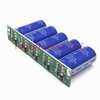GOAL: To continue to power my 12v DC automotive stereo for "x" seconds after power is turned off. Where X = 10, 15 or even 30 seconds - length is not vital at this point.
So in my noob-ness, I thought I could just get a big ass capacitor to do this job. Since I have no clue what amperage or wattage the device actually draws during normal use, my logic was just solve it by trial and error. Try one, if the delay was too short, try a bigger one. Too long? Try a smaller one.
My first attempt used this 12f SuperCapacitor device I found on eBay. Looks like below. The PCB has a "+" and a "-" so I hooked 12v source power to +, and stereo power wire to - Stereo did indeed power up when turning on the ignition - but instantly powered off when I switched the vehicle ignition off. No residual power effect after turning vehicle off (or so quick it was imperceptible).
I really expected this first try would be in the "too big" category. I kind of expected to have 12v power supplied to the stereo for TOO long after turning the vehicle off. Because this rack of caps just looks pretty big to me.
So now I'm thinking wiring it must not be as straight forward as putting it "inline" with the 12v supply power wire.
Did I wire it wrong? Or is 12f still not big enough to do the job? Or is my entire premise flawed?
Any help would be appreciated.
So in my noob-ness, I thought I could just get a big ass capacitor to do this job. Since I have no clue what amperage or wattage the device actually draws during normal use, my logic was just solve it by trial and error. Try one, if the delay was too short, try a bigger one. Too long? Try a smaller one.
My first attempt used this 12f SuperCapacitor device I found on eBay. Looks like below. The PCB has a "+" and a "-" so I hooked 12v source power to +, and stereo power wire to - Stereo did indeed power up when turning on the ignition - but instantly powered off when I switched the vehicle ignition off. No residual power effect after turning vehicle off (or so quick it was imperceptible).
I really expected this first try would be in the "too big" category. I kind of expected to have 12v power supplied to the stereo for TOO long after turning the vehicle off. Because this rack of caps just looks pretty big to me.
So now I'm thinking wiring it must not be as straight forward as putting it "inline" with the 12v supply power wire.
Did I wire it wrong? Or is 12f still not big enough to do the job? Or is my entire premise flawed?
Any help would be appreciated.


